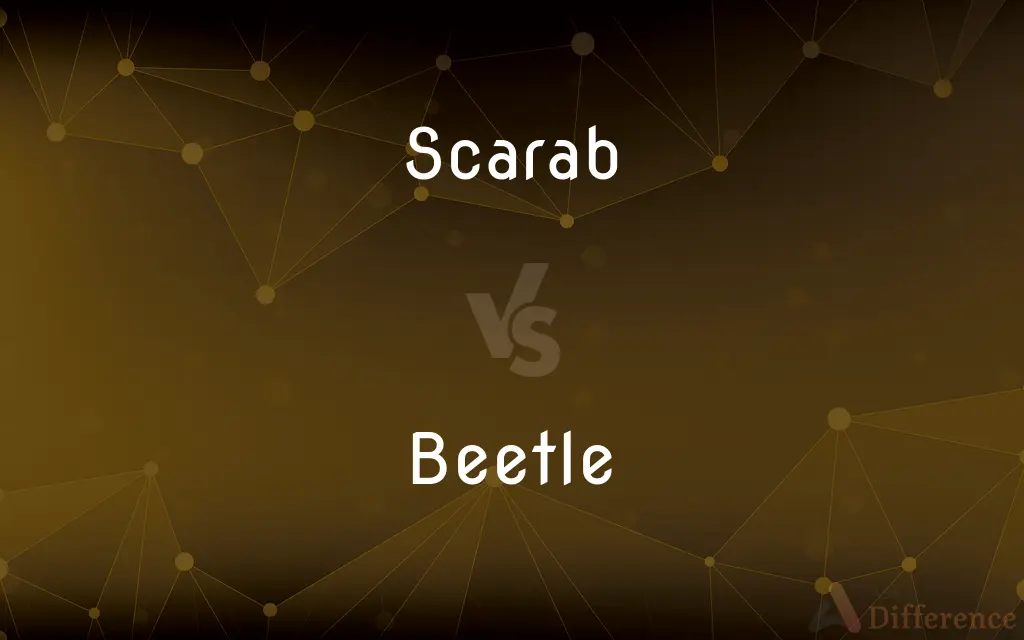Scarab vs. Beetle — What's the Difference?
By Urooj Arif & Fiza Rafique — Updated on April 27, 2024
A scarab is a specific type of beetle, revered in ancient Egypt and belonging to the family Scarabaeidae, while beetles are a diverse order of insects known as Coleoptera, which includes many different species including scarabs.

Difference Between Scarab and Beetle
Table of Contents
ADVERTISEMENT
Key Differences
Scarabs are distinguished within the beetle family for their cultural significance, particularly in ancient Egypt where they were symbolic of the sun god Ra. On the other hand, beetles represent the largest order of insects with over 350,000 species varying widely in size, shape, and habitat.
Scarabs are often characterized by their stout, rounded bodies and their habit of rolling dung into balls, which is behavior specific to dung beetles, a subgroup of scarabs. Whereas beetles can range from predatory species like ladybugs to wood-borers like bark beetles.
In terms of habitat, scarabs are predominantly found in warm climates where they play roles in decomposition and nutrient cycling. In contrast, beetles inhabit diverse environments from polar regions to tropical rainforests, adapting to a variety of ecological niches.
Scarabs often have a shiny, metallic or glossy appearance, which has contributed to their historical use as ornaments and amulets. Lower, beetles may display a range of colors and textures, adapted for camouflage, mating, or warning predators.
Regarding lifecycle, both scarabs and other beetles undergo complete metamorphosis with stages including egg, larva, pupa, and adult. However, the specific behaviors and roles of these stages can vary greatly among different beetle species.
ADVERTISEMENT
Comparison Chart
Taxonomic Rank
Subfamily within Scarabaeidae
Order Coleoptera
Symbolism
Symbolic in ancient Egypt
Varied, mostly not symbolic
Behavior
Dung rolling (some species)
Diverse, from predatory to detritivorous
Appearance
Often shiny, metallic
Wide range of colors and textures
Habitat
Predominantly warm climates
Extremely varied, nearly all environments
Compare with Definitions
Scarab
A type of beetle associated with ancient Egyptian religion.
The scarab amulet was thought to protect the pharaoh in the afterlife.
Beetle
Insects that can be found in almost every habitat except the sea and polar regions.
Beetles adapt to environments from deserts to forests.
Scarab
Specifically, a dung beetle regarded as sacred.
Scarabs roll dung into balls as a source of food.
Beetle
Many beetles are beneficial to the environment or agriculture.
Ladybugs help control aphid populations.
Scarab
Any of the beetles from the family Scarabaeidae.
Scarabs vary widely in size and color.
Beetle
Characterized by a particular hard and protective forewing.
The beetle's elytra protect it from predators.
Scarab
Used symbolically to represent rebirth or regeneration.
Scarabs are featured prominently in Egyptian iconography.
Beetle
Any insect of the order Coleoptera, having forewings hardened into wing-cases.
Beetles are known for their elytra, which cover the wings.
Scarab
An ornament or amulet shaped like a scarab beetle.
She wore a necklace adorned with a gold scarab.
Beetle
Varying greatly in size and form, from minute to large.
The titan beetle is one of the largest beetles.
Scarab
Any of numerous beetles of the family Scarabaeidae; a scarabaeid.
Beetle
Beetles are a group of insects that form the order Coleoptera (), in the superorder Endopterygota. Their front pair of wings are hardened into wing-cases, elytra, distinguishing them from most other insects.
Scarab
The scarabaeid beetle Scarabaeus sacer, regarded as sacred by the ancient Egyptians.
Beetle
Any of numerous insects of the order Coleoptera, having biting or chewing mouthparts and forewings modified to form horny coverings that protect the underlying pair of membranous hind wings when at rest.
Scarab
A representation of this beetle, such as a ceramic or stone sculpture or a cut gem, used in ancient Egypt as a talisman and a symbol of the soul. Also called scarabaeus.
Beetle
An insect resembling a member of the order Coleoptera.
Scarab
A beetle of the species Scarabaeus sacer, sacred to the ancient Egyptians.
Beetle
A heavy mallet with a large wooden head.
Scarab
Any species of beetle belonging to the family Scarabaeidae.
Beetle
A small wooden household mallet.
Scarab
A symbol, seal, amulet, or gem fashioned to resemble the sacred beetle.
Beetle
A machine with revolving wooden hammers that gives fabrics a lustrous sheen.
Scarab
Any one of numerous species of lamellicorn beetles of the genus Scarabæus, or family Scarabæidæ, especially the sacred, or Egyptian, species (Scarabæus sacer, and Scarabæus Egyptiorum).
Beetle
To make one's way or move like a beetle
"Chambermaids ... beetled from bedroom to bedroom loaded with ... champagne" (Vanity Fair).
Scarab
A stylized representation of a scarab beetle carved in stone or faience, or made in baked clay, usually in a conventionalized form in which the beetle has its legs held closely at its sides, and commonly having an inscription on the flat underside; - a symbol of resurrection, used by the ancient Egyptians as an ornament or a talisman, and in modern times used in jewelry, usually by engraving the formalized scarab design on cabuchon stones. Also used attributively; as, a scarab bracelet [a bracelet containing scarabs]; a ring with a scarab [the carved stone itelf].
Beetle
To jut; overhang
"The rocks often beetled over the road" (Washington Irving).
Scarab
Scarabaeid beetle considered divine by ancient Egyptians
Beetle
Jutting; overhanging
Beetle brows.
Beetle
Any of numerous species of insect in the order Coleoptera characterized by a pair of hard, shell-like front wings which cover and protect a pair of rear wings when at rest.
Beetle
(uncountable) A game of chance in which players attempt to complete a drawing of a beetle, different dice rolls allowing them to add the various body parts.
Beetle
Alternative case form of Beetle
Beetle
A type of mallet with a large wooden head, used to drive wedges, beat pavements, etc.
Beetle
A machine in which fabrics are subjected to a hammering process while passing over rollers, as in cotton mills; a beetling machine.
Beetle
To move (away) quickly, to scurry away.
He beetled off on his vacation.
Beetle
To loom over; to extend or jut.
The heavy chimney beetled over the thatched roof.
Beetle
To beat with a heavy mallet.
Beetle
To finish by subjecting to a hammering process in a beetle or beetling machine.
To beetle cotton goods
Beetle
Protruding, jutting, overhanging.
Beetle brows
Beetle
A heavy mallet, used to drive wedges, beat pavements, etc.
Beetle
A machine in which fabrics are subjected to a hammering process while passing over rollers, as in cotton mills; - called also beetling machine.
Beetle
Any insect of the order Coleoptera, having four wings, the outer pair being stiff cases for covering the others when they are folded up. See Coleoptera.
Beetle
To beat with a heavy mallet.
Beetle
To finish by subjecting to a hammering process in a beetle or beetling machine; as, to beetle cotton goods.
Beetle
To extend over and beyond the base or support; to overhang; to jut.
To the dreadful summit of the cliffThat beetles o'er his base into the sea.
Each beetling rampart, and each tower sublime.
Beetle
Insect having biting mouthparts and front wings modified to form horny covers overlying the membranous rear wings
Beetle
A tool resembling a hammer but with a large head (usually wooden); used to drive wedges or ram down paving stones or for crushing or beating or flattening or smoothing
Beetle
Be suspended over or hang over;
This huge rock beetles over the edge of the town
Beetle
Fly or go in a manner resembling a beetle;
He beetled up the staircase
They beetled off home
Beetle
Beat with a beetle
Beetle
Jutting or overhanging;
Beetle brows
Common Curiosities
Can beetles be found in cold climates?
Yes, some beetles are adapted to live in very cold climates, including polar regions.
Are all scarabs considered beetles?
Yes, all scarabs are part of the beetle order Coleoptera.
Why were scarabs important in ancient Egypt?
Scarabs were considered sacred and symbolic of the sun god Ra, representing rebirth and regeneration.
Do all beetles have the same type of lifecycle?
All beetles undergo complete metamorphosis, but the duration and specific behaviors during these stages can vary.
What is the main difference between a scarab and a beetle?
A scarab is a specific type of beetle known for its cultural significance and behaviors like dung rolling, while beetles are a broad order of insects with diverse characteristics.
How are beetles beneficial to the environment?
Many beetles help in decomposition, pollination, and as predators of pests.
Are there beetles that do not roll dung?
Yes, while some scarabs roll dung, many beetles have different behaviors and diets.
What makes scarabs unique among beetles?
Scarabs are unique for their historical and symbolic significance, particularly in ancient Egyptian culture.
What is the size range of beetles?
Beetles range from less than 1 mm to over 15 cm in length, depending on the species.
What kind of beetles live in urban environments?
In urban environments, you can commonly find beetles like carpet beetles and ladybugs.
Share Your Discovery

Previous Comparison
Fireman vs. Firewoman
Next Comparison
Put vs. PuttAuthor Spotlight
Written by
Urooj ArifUrooj is a skilled content writer at Ask Difference, known for her exceptional ability to simplify complex topics into engaging and informative content. With a passion for research and a flair for clear, concise writing, she consistently delivers articles that resonate with our diverse audience.
Co-written by
Fiza RafiqueFiza Rafique is a skilled content writer at AskDifference.com, where she meticulously refines and enhances written pieces. Drawing from her vast editorial expertise, Fiza ensures clarity, accuracy, and precision in every article. Passionate about language, she continually seeks to elevate the quality of content for readers worldwide.














































